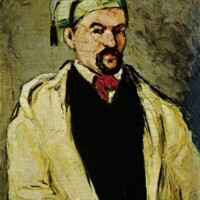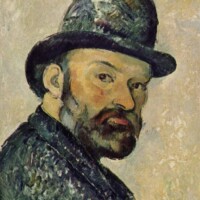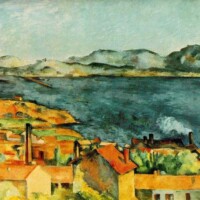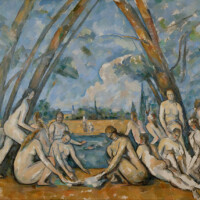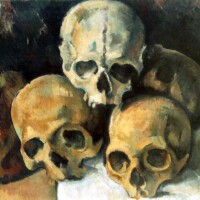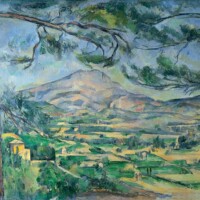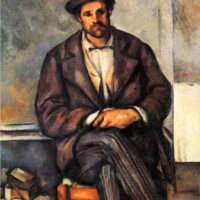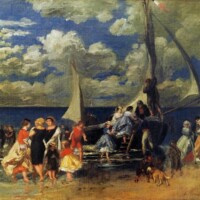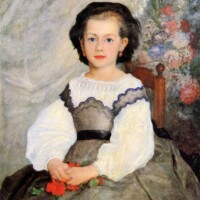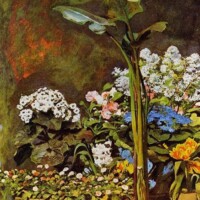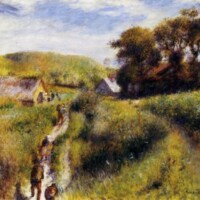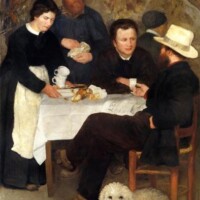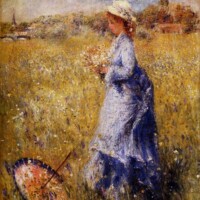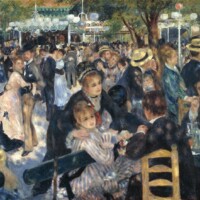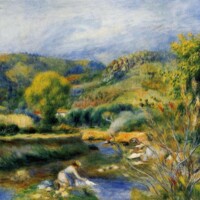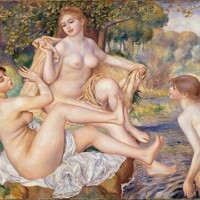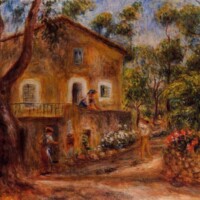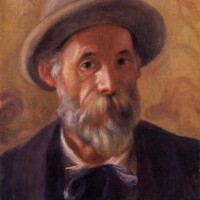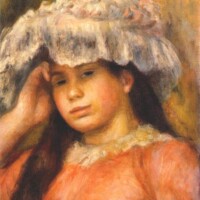Cezanne, Paul
Cezanne
(1839 - 1906)
Early Life and Beginnings (1839–1870)
Paul Cézanne was born on January 19, 1839, in Aix-en-Provence, France. His early life was shaped by his father's desire for him to pursue law, but Cézanne was drawn to art. Moving to Paris in 1861, he studied at the Académie Suisse and became friends with Émile Zola. Struggling to find acceptance, his early works were dark, influenced by Romanticism and Realism. Despite rejection from the art establishment, Cézanne remained determined, laying the foundation for his later innovations.
Click on a picture to enlarge it, then click the ⓘ button for more information
Artistic Evolution and Recognition (1870–1890)
In the 1870s, Cézanne became associated with the Impressionists, experimenting with color and light. Unlike his contemporaries, he sought structure and permanence in his subjects, focusing on form rather than fleeting effects. By the 1880s, Cézanne developed a unique style that emphasized geometric simplification and vivid color contrasts, gaining recognition from avant-garde artists. His works, such as the Mont Sainte-Victoire series, marked a turning point in modern art, influencing future movements like Cubism.
Click on a picture to enlarge it, then click the ⓘ button for more information
Maturity and Legacy (1890–1906)
Cézanne reached the height of his artistic powers in the 1890s, producing iconic works like The Card Players and The Large Bathers. Though reclusive, his reputation grew, and he influenced major artists like Picasso and Braque. His innovative use of form and perspective laid the groundwork for modern art. Cézanne died on October 22, 1906, in Aix-en-Provence, leaving behind a legacy as the "father of modern painting," inspiring generations of artists and reshaping the art world.
Click on a picture to enlarge it, then click the ⓘ button for more information
Renoir, Pierre-Augustine
Renoir
(1841 - 1919)
Humble Beginnings (1841-1864)
Born in Limoges, France, on February 25, 1841, Pierre-Auguste Renoir came from a working-class family. At age four, they moved to Paris, where he discovered his artistic talent painting porcelain in a factory. Although financial struggles limited formal education, he honed his skills through this work. Renoir enrolled in the prestigious École des Beaux-Arts in 1862, meeting future Impressionist artists like Claude Monet. He learned traditional techniques but grew increasingly dissatisfied, seeking a fresher approach to art. The bustling Parisian art scene and frequent visits to the Louvre deeply influenced his early aspirations as a painter.
Click on a picture to enlarge it, then click the ⓘ button for more information
Impressionist Revolution (1865-1883)
By the late 1860s, Renoir joined Monet, Sisley, and Bazille in experimenting with light and color, giving rise to Impressionism. Their 1874 exhibition was met with mixed reviews, but Renoir’s style—a vibrant blend of soft brushstrokes and luminous hues—began to draw attention. He painted lively scenes of Parisian life, such as *Dance at Le Moulin de la Galette* (1876), capturing fleeting moments. Financial hardship persisted until a patron, Paul Durand-Ruel, supported him. During this period, Renoir refined his technique, balancing traditional drawing with Impressionism’s freedom. By the 1880s, he began moving away from the movement's strict tenets.
Click on a picture to enlarge it, then click the ⓘ button for more information
Later Years and Legacy (1884-1919)
In the mid-1880s, Renoir sought new directions, focusing on classical forms and clarity. His travels to Italy reignited a passion for Renaissance art, influencing works like “The Large Bathers” (1887. Suffering from rheumatoid arthritis in his later years, he continued painting, even with limited mobility, producing masterpieces like “The Bathers” (1918). He remained prolific until his death on December 3, 1919. Despite his evolution away from pure Impressionism, Renoir's legacy as a master of color, warmth, and human intimacy cemented his place as one of the greatest painters in history.
Click on a picture to enlarge it, then click the ⓘ button for more information
Seurat, Georges
Coming soon.....
Cezanne, Paul
Cezanne
(1839 - 1906)
Early Life and Beginnings (1839–1870)
Paul Cézanne was born on January 19, 1839, in Aix-en-Provence, France. His early life was shaped by his father's desire for him to pursue law, but Cézanne was drawn to art. Moving to Paris in 1861, he studied at the Académie Suisse and became friends with Émile Zola. Struggling to find acceptance, his early works were dark, influenced by Romanticism and Realism. Despite rejection from the art establishment, Cézanne remained determined, laying the foundation for his later innovations.
Click on a picture to enlarge it, then click the ⓘ button for more information
Artistic Evolution and Recognition (1870–1890)
In the 1870s, Cézanne became associated with the Impressionists, experimenting with color and light. Unlike his contemporaries, he sought structure and permanence in his subjects, focusing on form rather than fleeting effects. By the 1880s, Cézanne developed a unique style that emphasized geometric simplification and vivid color contrasts, gaining recognition from avant-garde artists. His works, such as the Mont Sainte-Victoire series, marked a turning point in modern art, influencing future movements like Cubism.
Click on a picture to enlarge it, then click the ⓘ button for more information
Maturity and Legacy (1890–1906)
Cézanne reached the height of his artistic powers in the 1890s, producing iconic works like The Card Players and The Large Bathers. Though reclusive, his reputation grew, and he influenced major artists like Picasso and Braque. His innovative use of form and perspective laid the groundwork for modern art. Cézanne died on October 22, 1906, in Aix-en-Provence, leaving behind a legacy as the "father of modern painting," inspiring generations of artists and reshaping the art world.
Click on a picture to enlarge it, then click the ⓘ button for more information
Renoir, Pierre-Augustine
Renoir
(1841 - 1919)
Humble Beginnings (1841-1864)
Born in Limoges, France, on February 25, 1841, Pierre-Auguste Renoir came from a working-class family. At age four, they moved to Paris, where he discovered his artistic talent painting porcelain in a factory. Although financial struggles limited formal education, he honed his skills through this work. Renoir enrolled in the prestigious École des Beaux-Arts in 1862, meeting future Impressionist artists like Claude Monet. He learned traditional techniques but grew increasingly dissatisfied, seeking a fresher approach to art. The bustling Parisian art scene and frequent visits to the Louvre deeply influenced his early aspirations as a painter.
Click on a picture to enlarge it, then click the ⓘ button for more information
Impressionist Revolution (1865-1883)
By the late 1860s, Renoir joined Monet, Sisley, and Bazille in experimenting with light and color, giving rise to Impressionism. Their 1874 exhibition was met with mixed reviews, but Renoir’s style—a vibrant blend of soft brushstrokes and luminous hues—began to draw attention. He painted lively scenes of Parisian life, such as *Dance at Le Moulin de la Galette* (1876), capturing fleeting moments. Financial hardship persisted until a patron, Paul Durand-Ruel, supported him. During this period, Renoir refined his technique, balancing traditional drawing with Impressionism’s freedom. By the 1880s, he began moving away from the movement's strict tenets.
Click on a picture to enlarge it, then click the ⓘ button for more information
Later Years and Legacy (1884-1919)
In the mid-1880s, Renoir sought new directions, focusing on classical forms and clarity. His travels to Italy reignited a passion for Renaissance art, influencing works like “The Large Bathers” (1887. Suffering from rheumatoid arthritis in his later years, he continued painting, even with limited mobility, producing masterpieces like “The Bathers” (1918). He remained prolific until his death on December 3, 1919. Despite his evolution away from pure Impressionism, Renoir's legacy as a master of color, warmth, and human intimacy cemented his place as one of the greatest painters in history.
Click on a picture to enlarge it, then click the ⓘ button for more information
Seurat, Georges
Coming soon.....




